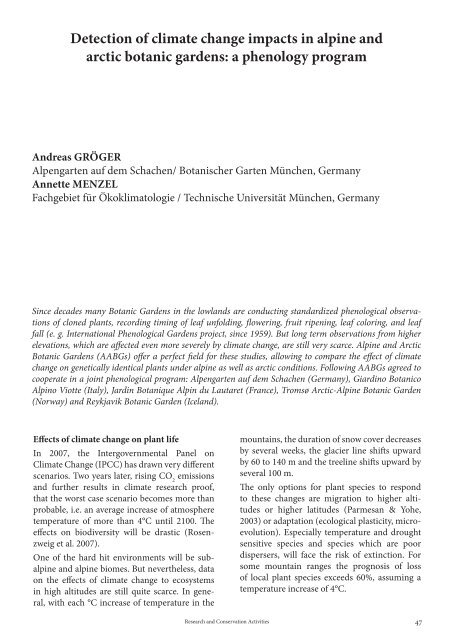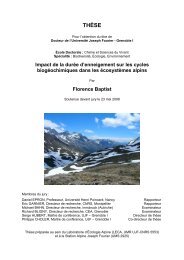2nd International Congress of Alpine and Arctic Botanical Gardens
2nd International Congress of Alpine and Arctic Botanical Gardens
2nd International Congress of Alpine and Arctic Botanical Gardens
You also want an ePaper? Increase the reach of your titles
YUMPU automatically turns print PDFs into web optimized ePapers that Google loves.
Detection <strong>of</strong> climate change impacts in alpine <strong>and</strong><br />
arctic botanic gardens: a phenology program<br />
Andreas GRÖGER<br />
Alpengarten auf dem Schachen/ Botanischer Garten München, Germany<br />
Annette MENZEL<br />
Fachgebiet für Ökoklimatologie / Technische Universität München, Germany<br />
Since decades many Botanic <strong>Gardens</strong> in the lowl<strong>and</strong>s are conducting st<strong>and</strong>ardized phenological observations<br />
<strong>of</strong> cloned plants, recording timing <strong>of</strong> leaf unfolding, flowering, fruit ripening, leaf coloring, <strong>and</strong> leaf<br />
fall (e. g. <strong>International</strong> Phenological <strong>Gardens</strong> project, since 1959). But long term observations from higher<br />
elevations, which are affected even more severely by climate change, are still very scarce. <strong>Alpine</strong> <strong>and</strong> <strong>Arctic</strong><br />
Botanic <strong>Gardens</strong> (AABGs) <strong>of</strong>fer a perfect field for these studies, allowing to compare the effect <strong>of</strong> climate<br />
change on genetically identical plants under alpine as well as arctic conditions. Following AABGs agreed to<br />
cooperate in a joint phenological program: Alpengarten auf dem Schachen (Germany), Giardino Botanico<br />
Alpino Viotte (Italy), Jardin Botanique Alpin du Lautaret (France), Tromsø <strong>Arctic</strong>-<strong>Alpine</strong> Botanic Garden<br />
(Norway) <strong>and</strong> Reykjavik Botanic Garden (Icel<strong>and</strong>).<br />
Effects <strong>of</strong> climate change on plant life<br />
In 2007, the Intergovernmental Panel on<br />
Climate Change (IPCC) has drawn very different<br />
scenarios. Two years later, rising CO emissions<br />
2<br />
<strong>and</strong> further results in climate research pro<strong>of</strong>,<br />
that the worst case scenario becomes more than<br />
probable, i.e. an average increase <strong>of</strong> atmosphere<br />
temperature <strong>of</strong> more than 4°C until 2100. The<br />
effects on biodiversity will be drastic (Rosenzweig<br />
et al. 2007).<br />
One <strong>of</strong> the hard hit environments will be subalpine<br />
<strong>and</strong> alpine biomes. But nevertheless, data<br />
on the effects <strong>of</strong> climate change to ecosystems<br />
in high altitudes are still quite scarce. In general,<br />
with each °C increase <strong>of</strong> temperature in the<br />
mountains, the duration <strong>of</strong> snow cover decreases<br />
by several weeks, the glacier line shifts upward<br />
by 60 to 140 m <strong>and</strong> the treeline shifts upward by<br />
several 100 m.<br />
The only options for plant species to respond<br />
to these changes are migration to higher altitudes<br />
or higher latitudes (Parmesan & Yohe,<br />
2003) or adaptation (ecological plasticity, microevolution).<br />
Especially temperature <strong>and</strong> drought<br />
sensitive species <strong>and</strong> species which are poor<br />
dispersers, will face the risk <strong>of</strong> extinction. For<br />
some mountain ranges the prognosis <strong>of</strong> loss<br />
<strong>of</strong> local plant species exceeds 60%, assuming a<br />
temperature increase <strong>of</strong> 4°C.<br />
Research <strong>and</strong> Conservation Activities 47




